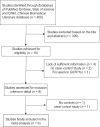Is There Any Association between Glutathione S-transferases M1 and Glutathione S-transferases T1 Gene Polymorphisms and Endometrial Cancer Risk? A Meta-analysis
- PMID: 28706616
- PMCID: PMC5499388
- DOI: 10.4103/ijpvm.IJPVM_346_15
Is There Any Association between Glutathione S-transferases M1 and Glutathione S-transferases T1 Gene Polymorphisms and Endometrial Cancer Risk? A Meta-analysis
Abstract
Epidemiological evidence on the association between genetic polymorphisms in glutathione S-transferases M1 (GSTM1) and T1 (GSTT1) genes and risk of endometrial cancer (EC) has been inconsistent. In this meta-analysis, we seek to investigate the relationship between GSTM1 and GSTT1 polymorphisms and the risk of EC. We searched Medline, PubMed, Web of Science, Embase, Chinese National Knowledge Infrastructure database, and Chinese Biomedical Literature database to identify eligible studies. The pooled odds ratios (ORs) with 95% confidence intervals (CIs) for the association were determined using a fixed- or random-effect model. Tests for heterogeneity of the results and sensitivity analyses were performed. A total of six case-control studies were included in the final meta-analysis of GSTM1 (1293 cases and 2211 controls) and GSTT1 (1286 cases and 2200 controls) genotypes. Overall, GSTM1 null genotype was not significantly associated with an increased risk of EC (OR = 1.00, 95% CI = 0.76-1.30, P = 0.982). Similarly, for GSTT1 deletion genotype, we observed no association under the investigated model in the overall analysis (OR = 0.91, 95% CI = 0.64-1.30, P = 0.619). Subgroup analysis also showed no significant association between the GSTM1 null genotype and EC risk in hospital-based design (OR = 1.26, 95% CI = 0.93-1.71, P = 0.131) and no relationship between GSTT1 null genotype with EC risk in population-based design (OR = 1.18, 95% CI = 0.79-1.76, P = 0.407). However, GSTM1 null genotype contributed to an increased EC risk in population-based design (OR = 0.76, 95% CI = 0.60-0.97, P = 0.027), while null GSTT1 in hospital-based studies (OR = 0.70, 95% CI = 0.52-0.93, P = 0.015). The present meta-analysis suggested that GSTs genetic polymorphisms may not be involved in the etiology of EC. Large epidemiological studies with the combination of GSTM1 null, GSTT1 null, and design-specific with the development of EC are needed to prove our findings.
Keywords: Endometrial cancer; glutathione S-transferases M1; glutathione S-transferases T1; meta-analysis; susceptibility.
Conflict of interest statement
There are no conflicts of interest.
Figures




Similar articles
-
Association of glutathione S-transferase M1/T1 polymorphisms with susceptibility to vitiligo.Gene. 2014 Feb 1;535(1):12-6. doi: 10.1016/j.gene.2013.11.024. Epub 2013 Dec 1. Gene. 2014. PMID: 24295891
-
Polymorphisms of glutathione S-transferase M1 (GSTM1) and T1 (GSTT1) and endometriosis risk: a meta-analysis.Eur J Obstet Gynecol Reprod Biol. 2014 Dec;183:114-20. doi: 10.1016/j.ejogrb.2014.10.032. Epub 2014 Oct 30. Eur J Obstet Gynecol Reprod Biol. 2014. PMID: 25461363
-
Association of glutathione S-transferase polymorphisms (GSTM1 and GSTT1) with primary open-angle glaucoma: an evidence-based meta-analysis.Gene. 2013 Sep 10;526(2):80-6. doi: 10.1016/j.gene.2013.05.032. Epub 2013 Jun 4. Gene. 2013. PMID: 23747403 Review.
-
Association between glutathione S-transferase M1/T1 gene polymorphisms and susceptibility to endometriosis: A systematic review and meta-analysis.Exp Ther Med. 2016 May;11(5):1633-1646. doi: 10.3892/etm.2016.3110. Epub 2016 Feb 26. Exp Ther Med. 2016. PMID: 27168783 Free PMC article.
-
The Association between GSTM1, GSTT1 Genetic Variants and Gastric Carcinoma Susceptibility in Chinese: A Systematic Review Article.Iran J Public Health. 2016 Sep;45(9):1103-1117. Iran J Public Health. 2016. PMID: 27957455 Free PMC article. Review.
Cited by
-
The prognostic impact of GSTM1/GSTP1 genetic variants in bladder Cancer.BMC Cancer. 2019 Oct 23;19(1):991. doi: 10.1186/s12885-019-6244-6. BMC Cancer. 2019. PMID: 31646988 Free PMC article.
-
Unveiling the etiological impact of GST-M1, GST-T1, and P53 genotypic variations on brain carcinogenesis.Mol Biol Rep. 2023 Dec 29;51(1):45. doi: 10.1007/s11033-023-08985-2. Mol Biol Rep. 2023. PMID: 38158432
References
-
- Cavalieri E, Frenkel K, Liehr JG, Rogan E, Roy D. Estrogens as endogenous genotoxic agents – DNA adducts and mutations. J Natl Cancer Inst Monogr. 2000;27:75–93. - PubMed
-
- Beckett GJ, Hayes JD. Glutathione S-transferases: Biomedical applications. Adv Clin Chem. 1993;30:281–380. - PubMed
-
- Bakkum-Gamez JN, Gonzalez-Bosquet J, Laack NN, Mariani A, Dowdy SC. Current issues in the management of endometrial cancer. Mayo Clin Proc. 2008;83:97–112. - PubMed
-
- Doherty JA, Weiss NS, Freeman RJ, Dightman DA, Thornton PJ, Houck JR, et al. Genetic factors in catechol estrogen metabolism in relation to the risk of endometrial cancer. Cancer Epidemiol Biomarkers Prev. 2005;14:357–66. - PubMed
Publication types
LinkOut - more resources
Full Text Sources
Other Literature Sources
Research Materials
Miscellaneous

